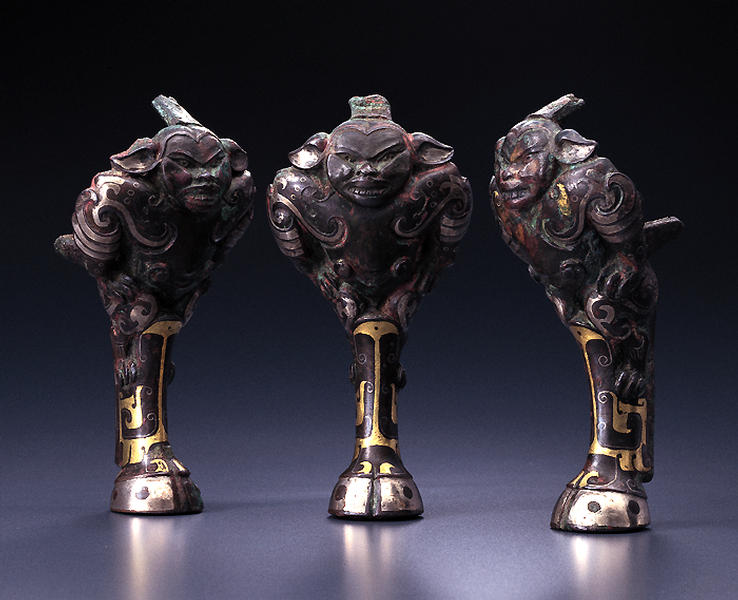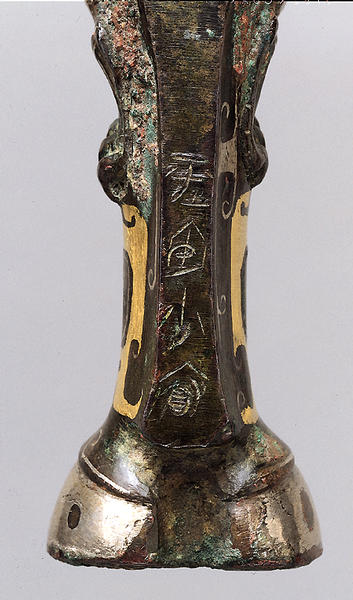器脚
- 中国
- 中国・東周時代後期-前漢時代初期
- 前300-前100年頃
- 青銅、金、銀
- H-11.6 D-5 W-5.8
この三本の器脚は獣脚に特有の翼を持つ仙境の魔物を組み合わせたもので、その前傾した背中には他の金属器から外された破損痕もなく、各々三本の取り付け金具の突起が見られることからおそらく底部が丸い形状の漆器の脚であったと想像される。一本の脚の後側に「少府」という秦時代以来の高位九階の一つが示されており、一時期皇帝の宝物に属した可能性が窺われる。
Catalogue Entry
Each of these three almost identical objects features a burly humanoid that sits, leaning forward, over a stiff bovine leg. Their round, fully modeled heads include projections like ears that extend to the shoulders; full, fleshy lips above big buck teeth mark the mouths. On the bodies below, layers of relief as well as gold and especially silver inlay give further detail to the forms.
The contours and composition of these extraordinary objects were inspired in part by their intended function as legs for a vessel. Three integral projecting pins behind the head and arms of each monster were made to anchor them into an object they no longer support. Beginning in the Eastern Zhou period (770-221 B.C.), certain containers--particularly ding tripods; spherical dui, yi and he pitchers; and pan basins--were provided with sculptural legs. Some represent single figures, while others combine two or more 1 In fact, a he pitcher from the Warring States period (475-221 B.C.) in the Palace Museum, Beijing, has legs quite similar to these.2 The Shumei legs apparently were not made to support a vessel of bronze like the Beijing one but a container of a different material, probably lacquer. This assumption is supported by laboratory analysis showing remains of wood and lacquer around the projecting pins on the backs.
One of the legs bears a four-character engraved inscription that names the office of the Shaofu, one of the nine highest ranking Chinese officials since Qin times.3 At its inception, the office was responsible for tax collection. In the Eastern Han period (25-220 A.D.), however, responsibilities were redefined and the department began to supervise the various garments and precious possessions of the emperor. Since it is engraved, the inscription could have been added to the leg at any time after manufacture. Because the faces of the creatures closely resemble those on a pair of gilt- and silvered-bronze coffin handles found in the royal tomb of Liu Sheng (died 113 B.C.), these legs most likely date to the very late Eastern Zhou or early Western Han period.4
JKW
1. Among the earliest Eastern Zhou examples are pan from Shandong held by human figures who face out, away from the vessel they carry on their backs; see Qufu Lu guo gu cheng 1982, pl. 76.1; Wenwu 1983.12, p. 2, figs. 4-5. Perhaps the most memorable example of legs composed of multiple beings is the Warring States spherical he in the Art Institute of Chicago (no. 30.366) that stands on humans crowned with birds: see Kelley and Ch'en 1946, pp. 108-11.
2. See Wenwu 1972.11, p. 61, fig. 3, pl. 2.
3. The title appears in other engraved versions: see, for example, Luo 1937, chap. 18, p. 39.
4. See Hebei sheng 1980, vol. 1, pp. 33-35; vol. 2, color pl. 3, pl. 15.1.

